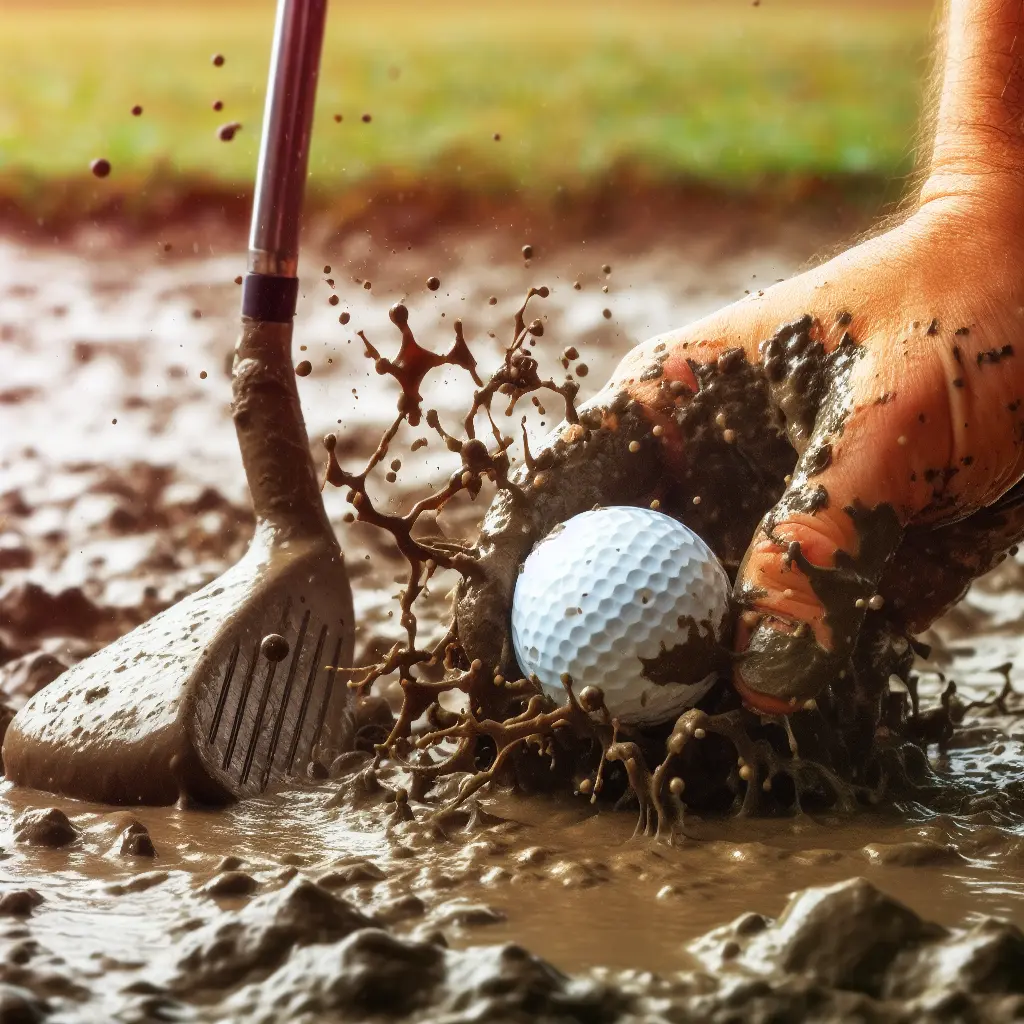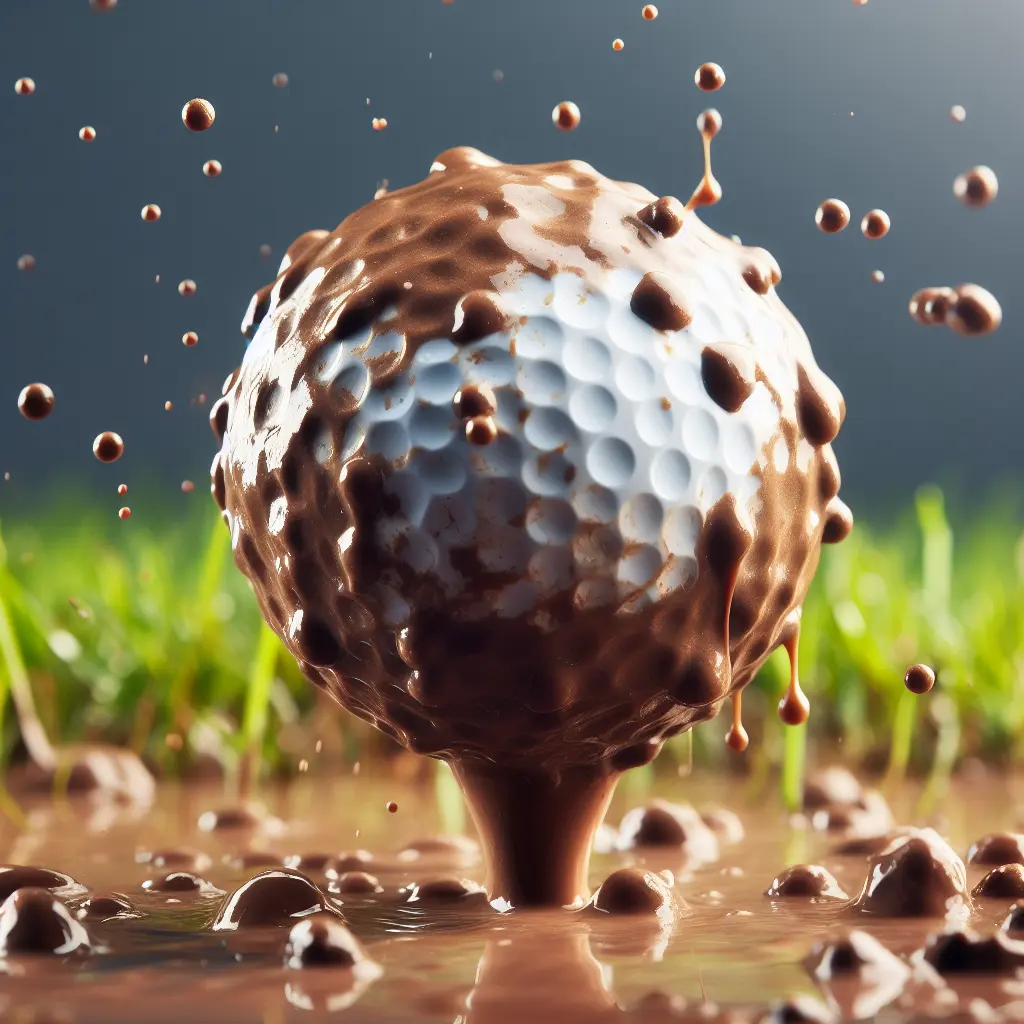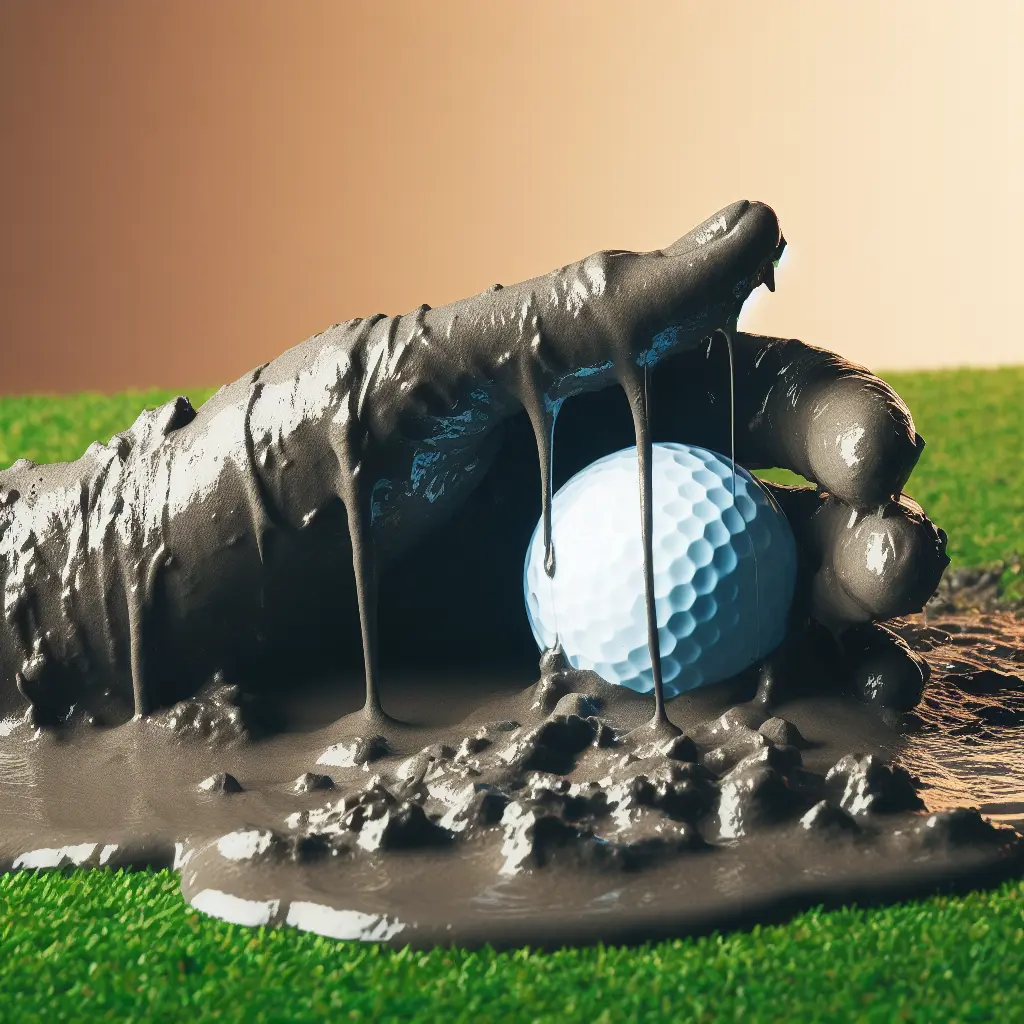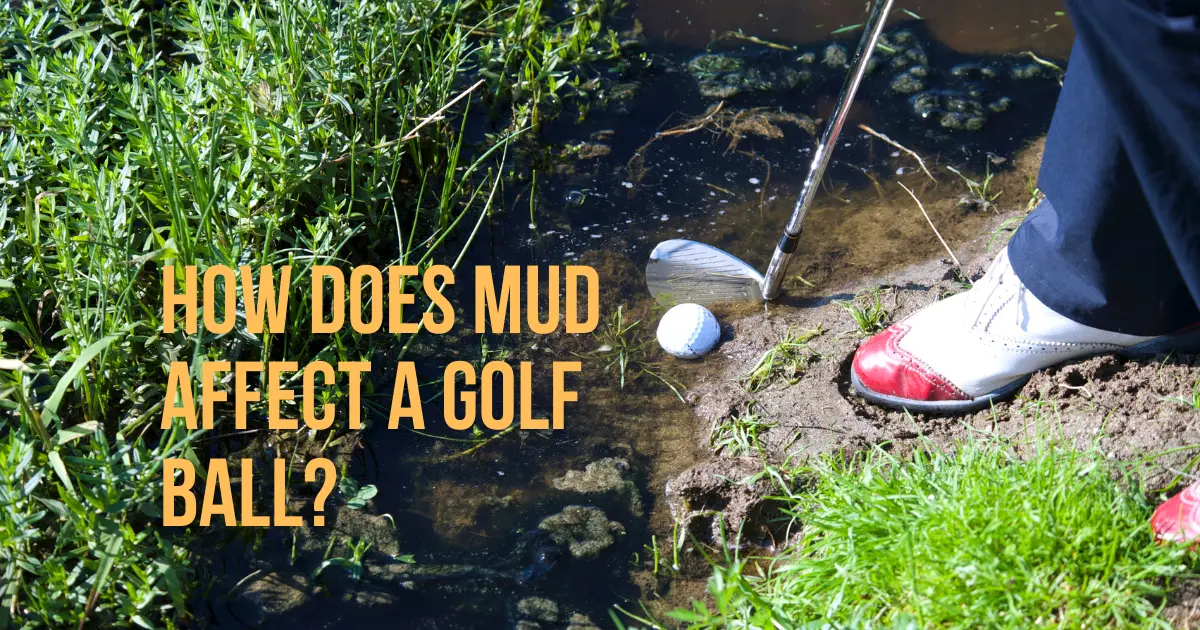When a golf ball comes into contact with mud, it can significantly alter its trajectory and flight path. If there is mud on the left side of the ball, it will cause the ball to spin in the opposite direction, resulting in a hook or a shot that veers to the left. Conversely, if there is mud on the right side of the ball, it will cause the ball to spin in the opposite direction, resulting in a slice or a shot that veers to the right. This alteration in the ball’s flight can be attributed to the uneven distribution of weight caused by the mud affect a golf ball, leading to an imbalance and erratic movement.



As a result, golfers may experience difficulty in accurately predicting the trajectory of the ball and it can negatively impact their overall performance. Therefore, it is crucial for golfers to carefully inspect and clean their golf balls to minimize the effects of mud on their game.
- What is a Mud Ball in Golf
- Mud Increases Weight and Changes Efficiency.
- Mud Buildup Alters Impact and Compression
- Spin Rates Are Reduced
- Mud Splatter Creates Visual Blockage
- Mud Affects Lie and Stance
- Increased Potential for Club Damage
- Find Mud on Your Ball
- Cleaning Mud from Balls and Clubs
- Impacts Vary by Golf Club Type
- Improving Lies and Footing
- FAQs
- Conclusion
What is a Mud Ball in Golf
A mud ball in golf refers to a situation where a significant amount of mud is stuck to the surface of the golf ball, typically accumulated when the ball makes contact with a wet or muddy surface. When a player hits a ball with mud on it, the flight of the ball is greatly affected. The additional weight and imbalance caused by the mud can cause the ball to curve in the opposite direction of the intended shot. This can result in a loss of distance and accuracy, as the mud affects the aerodynamics of the ball.
The amount of mud on the ball can also affect the carry distance, as the added weight and altered surface can cause friction with the air and reduce the overall flight of the ball. As a result, golfers often seek to clean the mud off their balls before making a shot to avoid any detrimental effects on their performance.
Mud Increases Weight and Changes Efficiency.
One of the most noticeable effects of mud on a golf ball is the added weight. As mud sticks to the ball, it makes the ball heavier. This can influence the distance the ball travels when hit. Heavy items require more force than lighter objects to travel the same distance. So a muddy golf ball will not fly as far as a clean ball when struck with the same club speed and impact.
The aerodynamics of the ball are also changed by the mud. The rough, uneven texture of dried or wet mud on the surface creates drag. This drag slows the forward motion of the ball during flight. Less aerodynamic balls curve less and do not travel as far overall. The mud essentially makes the ball less efficient in the air. It has the same effect as putting dimples on a smooth ball.
Mud Buildup Alters Impact and Compression
Mud buildup on a golf ball can significantly alter the impact and compression of the ball, ultimately affecting its performance. The placement of mud on the back or bottom of the ball can create an imbalance and disrupt the aerodynamics of the ball, leading to a decrease in ball speed and distance. When mud is present on the side of the ball, it can cause the ball to spin erratically, resulting in less accuracy and control. The science of mud balls has been studied extensively, and it has been determined that even a small amount of mud can affect a golf ball’s trajectory.
Players must be vigilant in inspecting their balls for mud buildup and promptly cleaning it off to avoid any adverse effects on their game. It is crucial to understand how mud can affect a golf ball and take proactive measures to mitigate its impact. Overall, the presence of mud on a golf ball can disrupt the balance and aerodynamics of the ball, ultimately affecting its speed, distance, and accuracy, thus highlighting the significance of maintaining a clean and mud-free ball for optimal performance.
Spin Rates Are Reduced
The amount of spin on a struck golf ball has a significant impact on the ball’s flight. Backspin generates lift and keeps the ball in the air for a longer period of time. Sidespin adds a curve or slice to the path of the shot. A golf club’s grooves are intended to impart spin. Mud, on the other hand, can get packed into the grooves, reducing their ability to spin the ball.
Mud also reduces natural friction at impact between the clubface and the ball. Lower spin rates result from reduced friction. Golf balls hit from muddy lies or with a mud-covered clubface spin significantly less than clean balls and clubs, according to tests. Shorter shot distances and less control over curve or trajectory result from spin loss.
Mud Splatter Creates Visual Blockage
During wet conditions, mud accumulates on more than just the ball. During a swing, the clubface also picks up mud. Mud can splatter across the surface of the ball when the muddy club strikes it. Mud splatter can obscure the golfer’s vision as they line up the next shot.
The ability to see the identifying marks and numbers on a golf ball is critical for alignment and shot setup. If mud splatters and obscures these visual cues, the golfer may find it more difficult to control their aim and ball position. This may result in inaccurate shots or errors in addressing the ball for the next swing.
Mud Affects Lie and Stance
Even if the ball itself is clean, a muddy area around it can impact how the golfer addresses the shot. The depth of the mud and the unevenness it causes will change the ball’s lie. Instead of sitting cleanly on grass, it may be partially submerged in mud. This can alter the contact point on the clubface and how the ball leaves the face when struck.
Additionally, the golfer may need to adjust their stance to account for the muddy conditions around the ball. Widening or shortening their stance to maintain balance or avoid slipping can change their swing mechanics. This can also contribute to less consistent ball striking and accuracy from mud.
Increased Potential for Club Damage
The presence of mud on the bottom of a golf ball can greatly affect its trajectory when struck by a club. When a player finds mud on their ball, particularly when hitting short game shots or when the ball is on the fairway, the potential for club damage becomes increased. The mud on the ball can disrupt the smooth flow of air around it, causing the ball to almost act as an entirely different object when struck. The mud can cause the ball to move in the opposite direction of what was intended, leading to potential mishits, loss of distance, and ultimately, a negative impact on a player’s performance.
The presence of mud on the ball can also lead to damage to the club itself. The unique spin and trajectory caused by the presence of mud can put a strain on the club, potentially leading to misalignment or even breakage. This increased potential for club damage due to mud on the ball underlines the importance of careful club and ball maintenance, as well as an understanding of how environmental factors such as mud can affect a golf ball during play.
Find Mud on Your Ball
It is important to ensure that your golf equipment remains clean and in good condition. One common issue that golfers may encounter is finding mud on their ball. It is important to promptly address this issue as mud can significantly affect the performance of a golf ball. When mud becomes stuck to a golf ball, it can alter its trajectory and affect its overall distance and accuracy. This can create challenges for golfers as they strive to achieve their best possible performance on the course.
Therefore, it is advisable to carefully inspect your ball before making a shot and remove any debris that may be present. It is also important to clean your golf balls regularly to prevent mud buildup, which can negatively impact your game. By taking these measures, you can ensure that your golf balls remain in optimal condition, allowing you to play your best game without being hindered by external factors such as mud on your ball.
Cleaning Mud from Balls and Clubs
When it comes to the game of golf, cleanliness and maintenance of equipment are of utmost importance. Mud, when accumulated on the ball and clubs, can significantly affect the performance and accuracy of shots. It is imperative to clean mud from balls and clubs before each game. The presence of mud makes the ball heavy and affects the aerodynamics during flight. To clean the ball, it is necessary to carefully inspect the back and top of the ball for any signs of mud.
A small amount of mud can drastically alter the trajectory and distance of the ball, making it essential to wipe off as much of the mud as possible. Using a towel or brush to remove the mud off the ball is recommended. In the case of the clubs, ensuring the grooves and clubface are free of any mud is crucial for achieving clean contact with the ball. It is important to devote enough time and attention to detail to effectively clean the mud from balls and clubs to ensure a consistent and accurate game.
Impacts Vary by Golf Club Type
The effect of mud also depends on the type of golf club being used. The design, swing speed, and impact compression varies for different clubs. As such, the degree of influence from mud will change across the bag.
Driver faces are more rounded and hit at higher swing speeds with lower compression. Mud has less impact here. But wedges have sharper grooves and attack angles that are more affected by mud. Iron shots tend to lose more distance and height from mud compared to woods due to club mechanics.
Improving Lies and Footing
When lies are muddy, golfers can take relief through free drops or improved lie procedures based on the rules. Taking advantage of these options or using a tee improves impact and swing consistency.
Golfers should also watch their footing and distribute weight for balance in muddy lies. Wearing spiked golf shoes provides traction. A wider stance aligns weight to prevent slipping. This allows swinging free of stability concerns that muddy lies introduce.
FAQs
How do you hit a mud ball in golf?
When hitting a golf ball with mud on it, focus on making solid contact and following through your swing. Trying to force the club through the mud or dirt can lead to mishits and fat shots. Let the momentum of your swing carry through the mud naturally. Also be prepared for reduced distance and ball flight changes compared to a clean ball.
Is a ball unfit to play if it has mud on it?
No, a golf ball with mud on it is still fit for play. However, mud can negatively affect the ball’s flight, spin, and distance performance. It is advisable to clean mud off golf balls before shots when possible. But there is no rule prohibiting playing a ball just because it has some mud on the cover.
What is mud ball?
In golf, a “mud ball” refers to a ball that has mud, dirt, or similar debris stuck to the cover from landing in a muddy lie or being exposed to wet conditions that leave moisture and dirt on the ball. The mud alters the aerodynamics and compression of the ball at impact, usually reducing distance.
What is the mud rule?
There is no specific “mud rule” in golf. However, golfers are allowed relief from muddy course conditions that are abnormal. If the mud would negatively affect a ball’s lie, stance, or swing, free relief is allowed under Rule 16-1.
Can you replace a damaged ball?
Yes, if a ball becomes damaged during the course of play, it can be replaced with another ball under Rule 5-3. Damage significant enough to impact the ball’s performance warrants a replacement, including cuts, cracks, or excessive scuffing. However, normal wear like grass stains or some mud does not require a replacement.
Conclusion
Mud can significantly influence the performance of golf balls when introduced through wet course conditions. The key effects of mud include reduced spin and distance, altered ball compression, and introduced variability in ball flights and lies. However, proper club and ball cleaning practices along with adjusting swing techniques can help counteract negative impacts. Strategic course selection and rules procedures also assist playing in muddy situations. With an understanding of how mud changes ball flight, golfers can adapt to maintain their playing standards even in the rain and mud.
